NEW Video & Podcast: Controlling Insects on Tropicals, Foliage
Tech On Demand dropped a new VIDEO and PODCAST this week and it’s gotten a lot of downloads already, for good reason. In this one, tropical and foliage plant expert Andrew Britten and I focus on insects, because they’re something a lot of you all across North America struggle with when finishing your tropical and foliage crops.
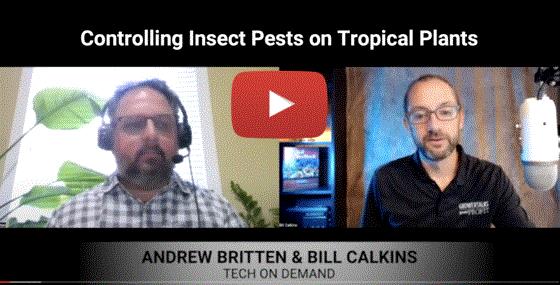
Andrew begins with an overview of the most common pests encountered in tropical plant production, and what kinds of damage to look for when identifying them. These “usual suspects” include aphids, spider mites, mealybug, whitefly and thrips. Then he turns his attention to managing and controlling these pests, talking about both conventional chemical and biological controls.
The goal with this video is to help you produce your best crops ever and send clean, healthy tropicals and foliage to market. Check it out and definitely share it with your production team. For the full slideshow Andrew shared, click HERE.
Be sure to subscribe to the Tech On Demand Podcast on any podcast app, so you never miss an episode. We’re on Apple, Spotify, Google, Audacy, Podbean and more. Also, find dozens of Tech On Demand videos on the BALL SEED YOUTUBE CHANNEL.

Nick’s Tip of the Week: Paclobutrazol Drenches for Garden Mums
Each week, I’ll work with my buddy Nick Flax, a technical services expert at Ball, to share a concern that’s come up during one of his numerous calls with growers across North America. This week, Nick has heard from a handful of mum growers looking for strategies to slow growth in an attempt to make sure mums are retail-ready when they ship.
PROBLEM: Thanks to Mother Nature and other weather-related factors, a lot of mum crops are coming along more quickly than anticipated, meaning the need to limit vegetative stretch and slow growth is immediately critical. Paclobutrazol drenches are certainly an option at this time of year.
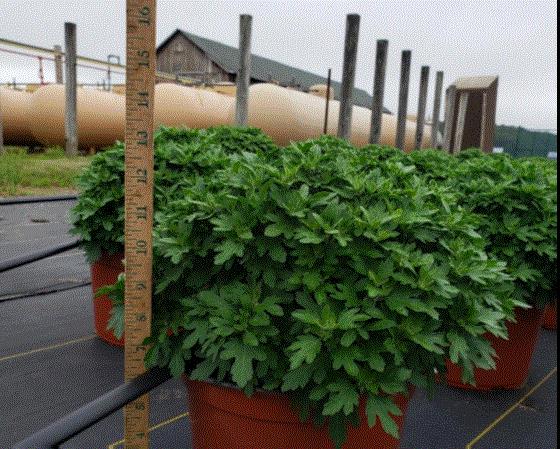
NICK’S TIP: Here are some best practices for paclobutrazol drenches for your mum crop.
There are two functional ways to use paclo drenches in mum production:
-
Low application rates in the early or middle stages of production to tone and limit vegetative stretch.
-
Higher application rates (relatively speaking) to cause a hard stop on mature crops that are budded but haven't stopping growing when you want them to.
PGR drenches have a more potent effect per ppm of active ingredient than foliar sprays at the same rate, so only use drenches when your decision is backed up by data—growth trends from graphical tracking.
Other things to consider before applying a paclo drench include:
-
If applying through a drip irrigation system, use pressure-compensating drip emitters. Failure to do so will cause a BIG difference in the amount of PGR applied to pots closer to your injector or water source versus the pots furthest away. If your drippers are not pressure-compensating, drenching via your irrigation system may not be a good option.
-
Different container sizes call for different amounts of PGR solution. Here’s a link to the Bonzi drench guide from Syngenta. The table at the bottom of page 6 offers recommendations on how much solution to apply to different-sized pots.
-
If you use a rate between 0.5 and 1 ppm, going a little over the recommended fluid ounces of PGR solution per pot won’t be the end of the world. Overdoing it at 2 ppm or higher, however, could spell disaster if you’re trying to check early- or mid-season growth spikes.
-
Never drench paclo (or ANY PGRs, for that matter) when the soil is dry OR saturated. Time your application so media is at a MODERATE moisture level before a drench application. Also, if growing outside, avoid drenching right before a heavy rain.
Paclobutrazol Drench Execution
If you’re drenching pot-by-pot, a chem-doser, which applies a precise amount of solution each time you pull the trigger, will yield the best results. Highly skilled applicators can get close to the target volume per pot using a breaker and shutoff valve and counting the seconds the valve is open, but the chances of applying variable amounts of PGR across the crop is very high using this method. As such, a drip irrigation system with pressure-compensating emitters is the best alternative if you don’t have a chem-doser.
With the BMPs above in mind, the following approach will help you hit your target PGR volume per pot right on the nose (or darn close to it):
-
Calculate the total amount of stock solution needed to treat all pots. For this, you’ll need the fl. oz. of PGR solution per pot based on container size, the number of pots you’re treating, desired rate of paclo, and your injector ratio.
-
Mix up the amount of solution than you need at the desired rate and add a generous amount of colored dye to the stock bucket.
-
Put a measuring cup or graduated cylinder under an unoccupied dripper about 1/2 to 2/3 of the way down the supply line (or punch an extra one in). This will be your “monitor dripper.”
-
Start the drench and run it until the PGR stock solution runs out. When the PGR stock bucket is empty, swap it for a clear water bucket and continue to run the injector. You’ll want to monitor the volume applied using the measuring device under your monitor dripper as the drench runs. This will ensure that enough solution is applied and serve as an insurance policy in case you miscalculated and made more stock solution than needed (which would lead to over-PGRing if it’s all applied). If you collect 90 to 95% of the target drench volume from your monitor dripper and there’s still a significant amount of paclo stock solution left, switch from the PGR stock bucket to the clear water bucket ASAP.
-
Run the injector with the clear water bucket until the colored dye is no longer noticeable in the droplets coming out of your monitor dripper. This indicates that the system has been cleared of PGR solution and ensures that all the active ingredient has been applied to your crop.
The result should be an even paclo application and uniform control of growth across your crop. Regular dripper maintenance and cleaning of filters in your system are critical to ensure each pot receives the same amount of PGR. Be sure to check drip emitter output uniformity across the entire system and make necessary repairs or modifications to equilibrate dripper output before you attempt to apply a paclobutrazol drench through your system.

Finish Fall Pansies STRONG!
In the final stages of the fall pansy game, it’s really all about preventing good pansies from going bad during the most challenging weather conditions of the season. You really need to stay on your game to avoid issues and ship the plants to retail or landscape customers with the best likelihood of success.
I recently spoke to (now retired) Ball tech services manager Dr. Will Healy about this critical time in fall pansy production and wrote it up in GrowerTalks, but I wanted to share this info again since it’s immediately relevant.

We started by addressing the elephant in the room, a challenge most pansy growers have faced and one that always catches you off guard and appears out of nowhere: Pansy Mottle Syndrome. Will explains this has plagued growers for decades, from about the time when pansies took off as a major crop. You’ll spot it when tips abort and the margins on mature and young leaves turn a creamy white. The symptoms occur randomly in different varieties and within different plantings. The result? Plants have abnormal growth and stop flowering.
The cause has been challenging to determine, but Will says it almost always traces back to a major stress event.
“High relative humidity and wet roots when the soil is saturated is usually the case, and it’s not corrected by boron application.” The simple answer is, Will says, is don’t stress out your plants. Leave them alone. “The one thing we know is it’s not disease,” he adds.
With the goal of reducing incidents of stress, continue to manage irrigation carefully. Don’t leave the plants saturated. Instead, water to level 4 and dry down to level 2. You also need to be sure to eliminate grow-out issues. Be sure to use new, fresh soil in your finished production. Old media often loses its nutrient charge and wetting agent, so be sure to test your nutrient levels (pH and EC at the minimum) before using existing soil. Also, make sure your soil is dry at the time of planting, Will says. Knowing the risk factors ahead of time allows you to create a fertilization program that matches the plant need.
As the crop’s growth rate increases, you’ll need to apply nitrogen at the correct rate. Don’t just add the same rate of N throughout the entire crop cycle; adjust as the plants grow to avoid “runts,” Will reminds us. Along the same lines, as temperatures rise and the plants grow faster, the rate of drying changes, so be sure to adjust your irrigation as you go. PGRs also are consumed more quickly in higher temperatures, so keep a close eye on rates to avoid stretch.
If you’ve treated plugs with fungicides and continued to treat during production, don’t let your guard down as you move to finish. Thielaviopsis is still the major concern—and remember, there’s no curative solution.
I’ll close with Will’s expert tips on setting up your crop for the best post-harvest performance for your customers and the end consumer:
-
Feed before shipping with an NH4-based fertilizer at about 200 ppm
-
Apply the appropriate fungicides to ensure a healthy crop for your customers
-
Only use PGRs until one week before shipping
-
Cooling down the soil as much as possible before shipping will help you avoid many issues

Quick Tech Tip: Anthracnose on Fall Pansies
Staying on the topic of pansies, the Tech On Demand team heard from a grower who noticed leaf spots appearing on some of his crop. The team quickly let him know that it looks like anthracnose, or Colletotrichum, and to remove and destroy severely affected plants. Ways to avoid this pathogen include avoiding prolonged periods of plant wetness and stress related to low nutrition. Suggested chemical controls include Mancozeb, Thiophanate-methyl, Trifloxystrobin, Boscalid and Pyraclostrobin.
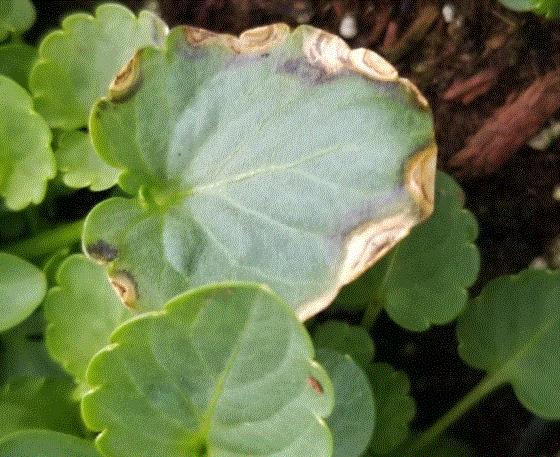
For even more info about anthracnose (and other pansy diseases), check out this INFORMATIONAL TABLE from Penn State Extension. The PSU experts concisely present the common diseases, symptoms, pathogen/cause and management strategies.
More Leaf Spots—but on Peppers
As always, fall crop production leads to many calls, emails and texts to the Tech On Demand team. Like the tip above, a grower reached out with leaf spots, but this time on peppers. The crop was looking good—clean and green—and then all of a sudden, “it just exploded into leaf spots.”
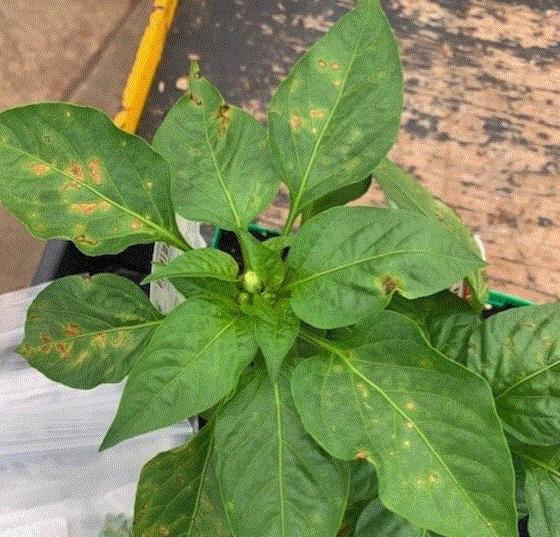
When the tech experts looked at the photo, they agreed it certainly appeared to be Xanthomonas. Thankfully, they could pass along THIS ALERT from our friends at e-GRO. According to the alert, minimizing wetness—especially at night—is a good way to avoid this disease. Try to water early in the day and not just before dusk.
Another strategy to minimize risk and spread of Xanthomonas is to avoid handling plants when they’re still wet. And—you can probably guess this one—greenhouse sanitation between crops is critical. Bacteria can survive for a long time, so as they say, start clean and stay clean. More on that next.
Friendly Reminder: Sanitation
How many times have I mentioned sanitation over the 80-plus weeks this newsletter has hit your inbox? Let’s just say A LOT. But as you wrap up fall crops (and soon enough, poinsettias) it’s going to be a good time to deep clean your structures, surfaces and anywhere else you can get to.
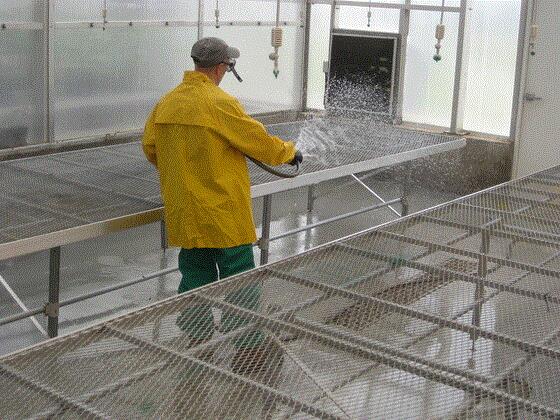
This FACT SHEET from University of Massachusetts is very thorough and covers just about everything you and your team need to remember when sanitizing. From benches and worktables to structures and even containers and your own hands, cleanliness is the best way to avoid disease spread and protect crops from all sorts of issues. I’d suggest bookmarking this fact sheet, sharing it with your entire team, and covering the topic in a group meeting. The importance of greenhouse sanitation cannot be overstated, and as often as I reference the topic, you should probably be talking about it even more than I do.
Here's a list of steps to prevent disease contamination, as suggested by UMass:
-
Disinfect benches—preferably, benches made of wire. Wood benches can be a source for root rot diseases and insect infestations. Algae growing on wood surfaces create an ideal environment for fungus gnats and shore flies. Plant pathogens such as Pythium can grow within the wood and plants rooting into the wood can become infected.
-
Pots, flats and trays should be new or disinfected
-
Disinfect potting tables, preferably made of a non-porous surface such as laminate.
-
Set up washing stations for hand washing and foot baths at the entrances of each greenhouse, especially propagation houses.
-
Keeping hands and fingernails clean can help reduce the spread of diseases. If wearing latex or other protective gloves, clean as you would your hands and change periodically. Change the disinfectant daily in foot baths and wash floor mats weekly.
-
Keep pets off of benches and potting areas.
-
Provide supports throughout the greenhouse to hang hose nozzles. Keep all containers and hose nozzles off the floor to prevent contamination with pathogens.
-
Keep growing media in a clean area, and covered.
-
Avoid carrying over plant material.
-
Avoid accumulating dirty pots, old growing media or plant debris in the media mixing area.
-
Make sure trash bins in the greenhouses are covered so that disease spores do not spread to the crop.
-
Use horticultural oil on vegetation/weeds outside, around the greenhouse perimeter, to smother over-wintering pests.

Finish Line …
That was a lot of info for one newsletter and you’re all super busy, so let’s keep this Finish Line short and sweet:
One of the most energizing things we can witness in this industry is meeting young folks with a passion for horticulture.
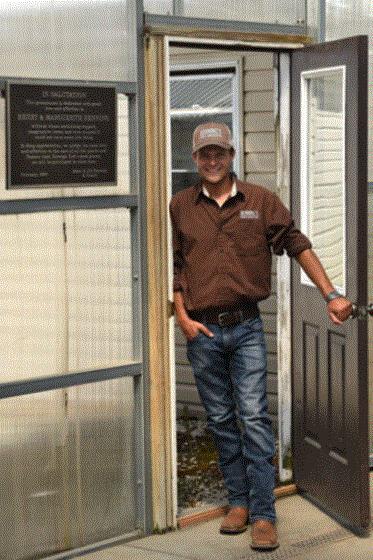 Every year, GrowerTalks recognizes these passionate young growers, and at the annual Cultivate show, we name one Young Grower Award winner. This year, it’s Quinten Herring, who’s working toward becoming the fourth-generation owner of Henning’s Farm & Greenhouses in DeMotte, Indiana. And he’s only 23!
Every year, GrowerTalks recognizes these passionate young growers, and at the annual Cultivate show, we name one Young Grower Award winner. This year, it’s Quinten Herring, who’s working toward becoming the fourth-generation owner of Henning’s Farm & Greenhouses in DeMotte, Indiana. And he’s only 23!
Quinten was selected from a fantastic group of finalists by a panel of judges and in addition to winning a trip to Cultivate, he’s featured on the cover of the current issue of GrowerTalks. Read all about Quinten and how he’s helping take the family business to the next level in WISE BEYOND HIS YEARS.
Congrats to Quinten and a big shout out to all of you young growers reading this newsletter! You are the future of the industry we all know and love.



Please feel free to send your comments, constructive criticism and topic ideas to me at bcalkins@ballhort.com.

Bill Calkins
Editor - Tech On Demand
This email was received by you and 25,871 other fine subscribers!
If you're interested in advertising in Tech On Demand, contact Kim Brown ASAP and she'll hook you up.